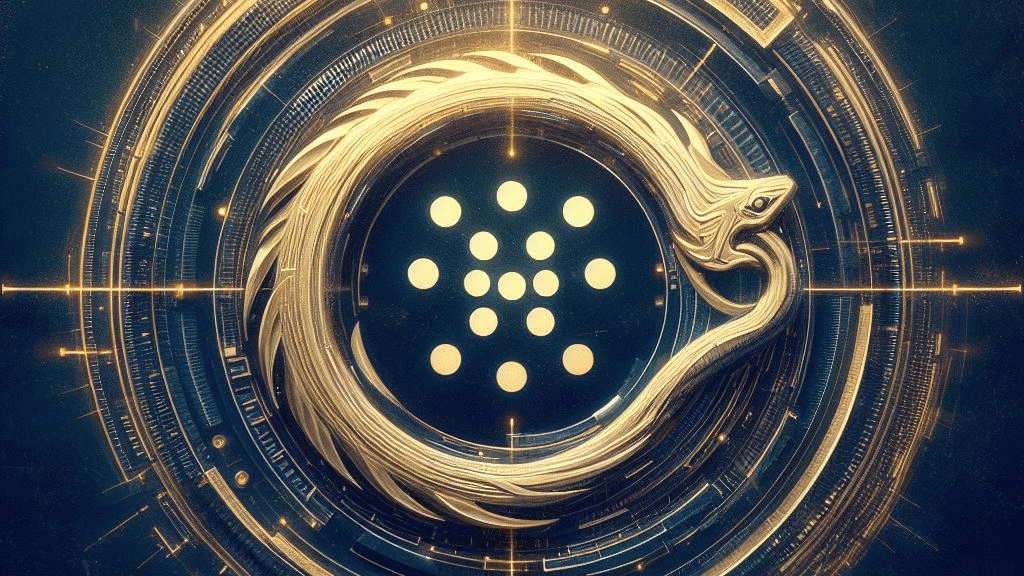
Cardano’s Ouroboros Protocol: The Engine of Innovation
In the intricate realm of blockchain technology, Cardano’s Ouroboros protocol stands as an exceptional creation, driving the blockchain’s uniqueness. Regarded as the first ‘provably secure’ Proof-of-Stake (PoS) consensus mechanism in the cryptocurrency world, Ouroboros is the foundation of Cardano’s unmatched decentralization, scalability, and energy efficiency. This article aims to unveil the intricacies of Ouroboros, exploring how it functions and what sets it apart from other blockchain networks.
Understanding Ouroboros
The term “Ouroboros” traces its origins to ancient mythology, symbolizing a serpent or dragon devouring its own tail—an emblem of the cyclical nature of existence. In the realm of cryptocurrency, Ouroboros is Cardano’s chosen consensus mechanism, orchestrating the algorithmic process of validating and adding new blocks to the blockchain network. It serves as the powerhouse behind Cardano’s array of decentralized applications (dApps) and Cardano Non-Fungible Tokens (CNFTs).
Ouroboros acts as the heartbeat of the Cardano network, ensuring its security, sustainability, and seamless operation. This PoS protocol is grounded in meticulous peer-reviewed research and cryptography, cementing its role as the bedrock of Cardano’s functionality. To simplify the complexities, we distill the Ouroboros consensus protocol into three fundamental features:
1. Epochs and Slots: Epochs mark the passage of time within Ouroboros, representing periods during which a fixed number of blocks are created, often spanning several days. Each epoch is further divided into slots—short intervals for block creation, with durations determined by network parameters. In each slot, a designated slot leader is responsible for adding a new block to the blockchain.
2. Leaders and Stake Pools: Cryptographic randomness plays a pivotal role in selecting a block leader for each slot from a pool of eligible validator nodes, chosen based on their stake in the network. The higher the amount of ADA staked, the greater the likelihood of selection as a slot leader. Slot leaders are entrusted with verifying and validating transactions within newly created blocks. Users can delegate their stake to a stake pool—a consortium of validators collaborating to become slot leaders and create blocks. Stake pools receive rewards for their contributions, and delegators earn a share of these rewards. This system ensures that network participants do not require vast quantities of ADA to earn staking rewards, promoting decentralization.
3. Rewards and Incentives: Slot leaders and stake pool operators receive ADA emissions as rewards for staking ADA tokens and securing the network. These rewards serve as incentives for network participants and contribute to the network’s decentralization.
The Evolution of Ouroboros
As with any element in the cryptocurrency space, Cardano’s Ouroboros protocol remains dynamic, subject to continuous updates and enhancements to meet the evolving demands of the industry. Ouroboros has seen several iterations, each building upon the foundations laid by its predecessor:
1. Ouroboros Classic: The inaugural version of Ouroboros aimed to provide an efficient and environmentally friendly alternative to energy-intensive consensus mechanisms like Bitcoin’s Proof-of-Work. It introduced unbiased randomness through publicly verifiable secret sharing (PVSS) to ensure fair and decentralized leader selection.
2. Ouroboros BFT: This iteration introduced Byzantine Fault Tolerance (BFT), enhancing the network’s resilience to bad behavior and maintaining integrity even in the presence of malicious actors. It served as a transitional protocol during Cardano’s Shelley era, facilitating network upgrades and smooth transitions during hard forks.
3. Ouroboros Praos: Praos introduced adaptive security to fortify Cardano against common network attacks like Distributed Denial of Service (DDoS). It implemented stake-based leader selection using verifiable random functions (VRFs) and operated under a semi-synchronous network model for flexibility and resilience.
4. Ouroboros Genesis: This implementation focused on eliminating the need for centralized checkpoints, enabling participants to join Cardano without relying on such checkpoints. It marked a significant step toward genuine decentralization, ensuring an open, inclusive, and resilient network.
5. Ouroboros Crypsinous: Although not expected to be deployed on Cardano, Crypsinous aimed to enhance privacy through SNARK technology, enabling users to prove knowledge of sensitive data without revealing the data itself.
6. Ouroboros Chronos: Named after the Greek Titan of Time, Chronos introduced asynchronous consensus, enabling network agreement and cohesion despite variations in message delivery times. It offered flexibility in timekeeping and slot management.
Pros and Cons of Ouroboros
Ouroboros brings a plethora of benefits to the Cardano ecosystem, but it is not devoid of limitations. Let’s explore some of its pros and cons:
Pros:
Sustainability: Operating on a proof-of-stake model, Ouroboros significantly reduces energy consumption compared to proof-of-work systems.
Adaptability: The protocol’s continuous evolution showcases developers’ commitment to improving the Cardano network.
Security: Ouroboros boasts a provably secure framework that excels in resisting blockchain hacks and malicious actors.
Privacy and Confidentiality: Advanced cryptographic techniques strike a balance between user privacy, data confidentiality, and network transparency.
Cons:
Complexity: The intricate design and continuous evolution of Ouroboros pose challenges for users and developers seeking to stay up-to-date.
Slow Progress: Cardano often faces criticism for extended development periods, leading to frustration among ADA holders and network supporters.
On the Flipside: Ouroboros, despite its sophistication, is essentially a Proof-of-Stake consensus mechanism, akin to many others in the cryptocurrency space. Numerous Layer-1 blockchains, including Ethereum, Solana, and Algorand, employ similar protocols to secure their networks.
Why Ouroboros Matters
Ouroboros serves as the heartbeat of the Cardano network


Get the latest Crypto & Blockchain News in your inbox.